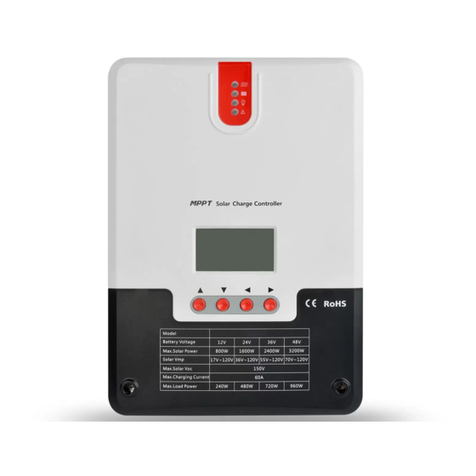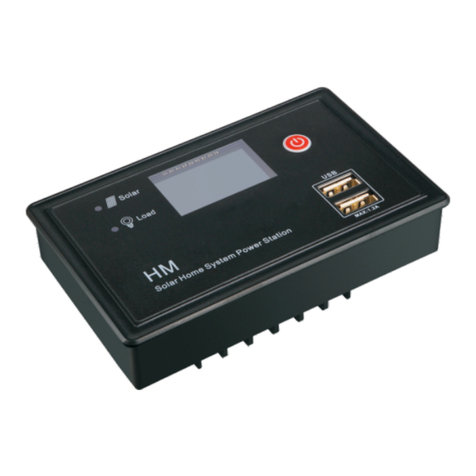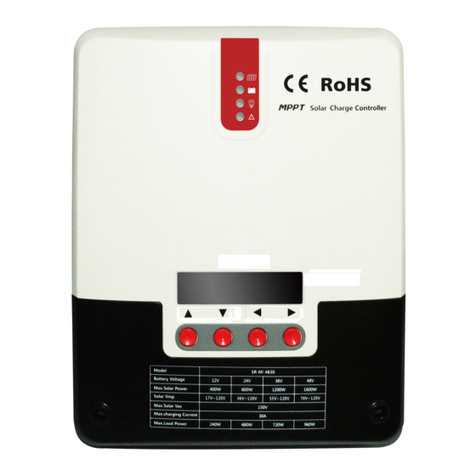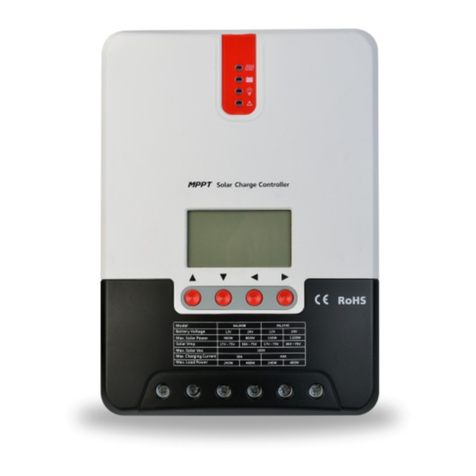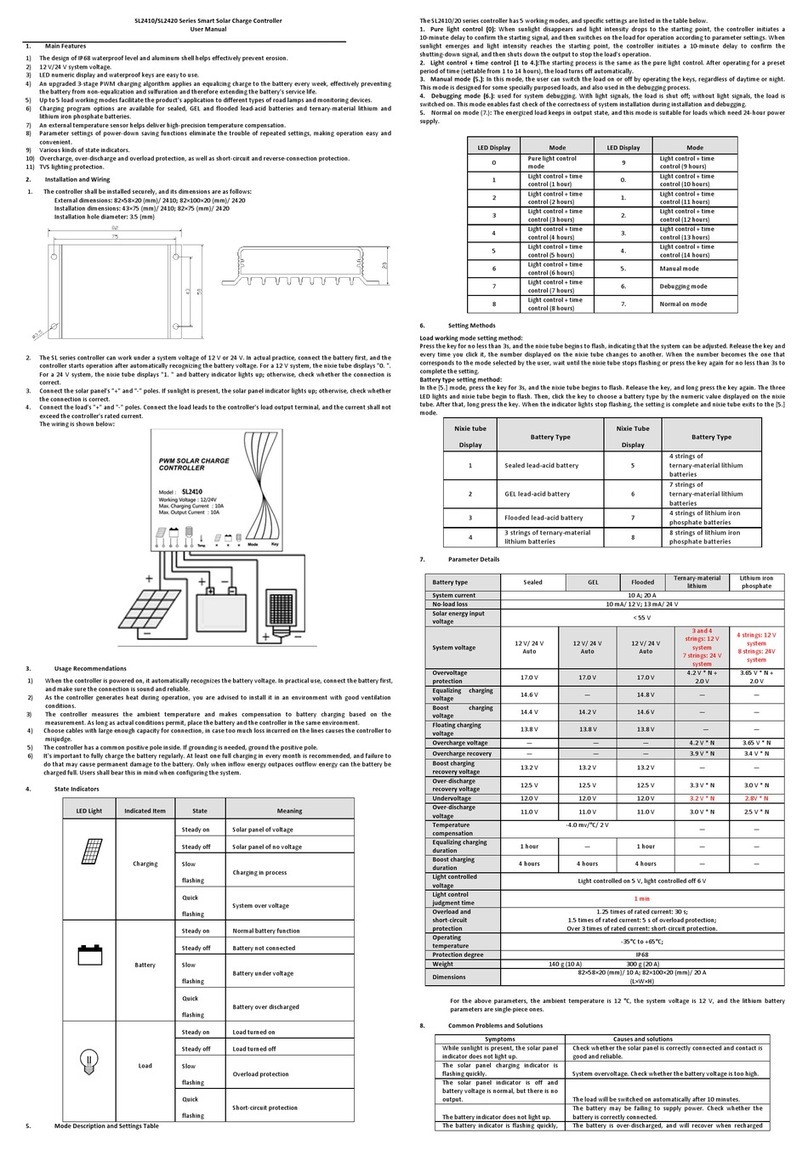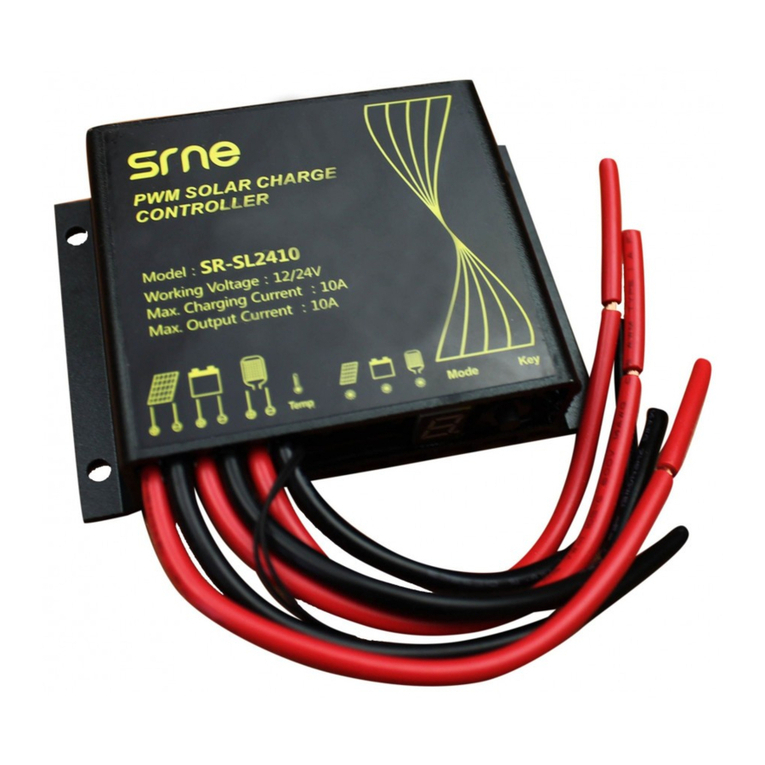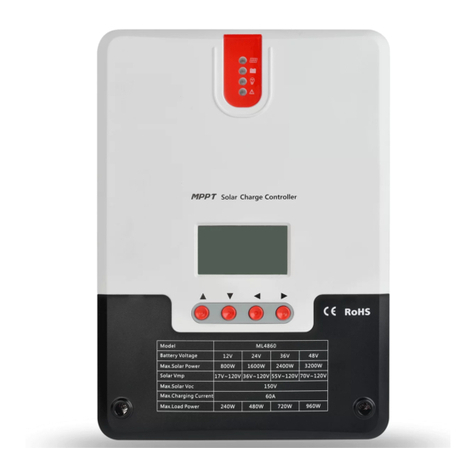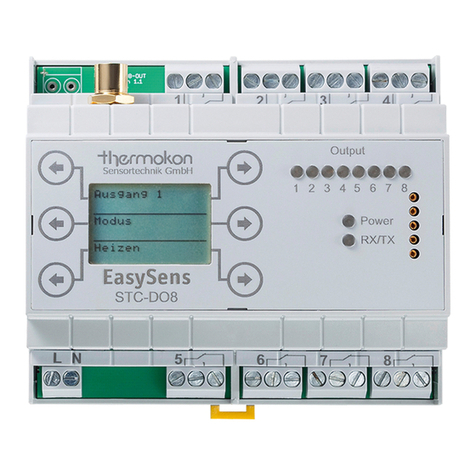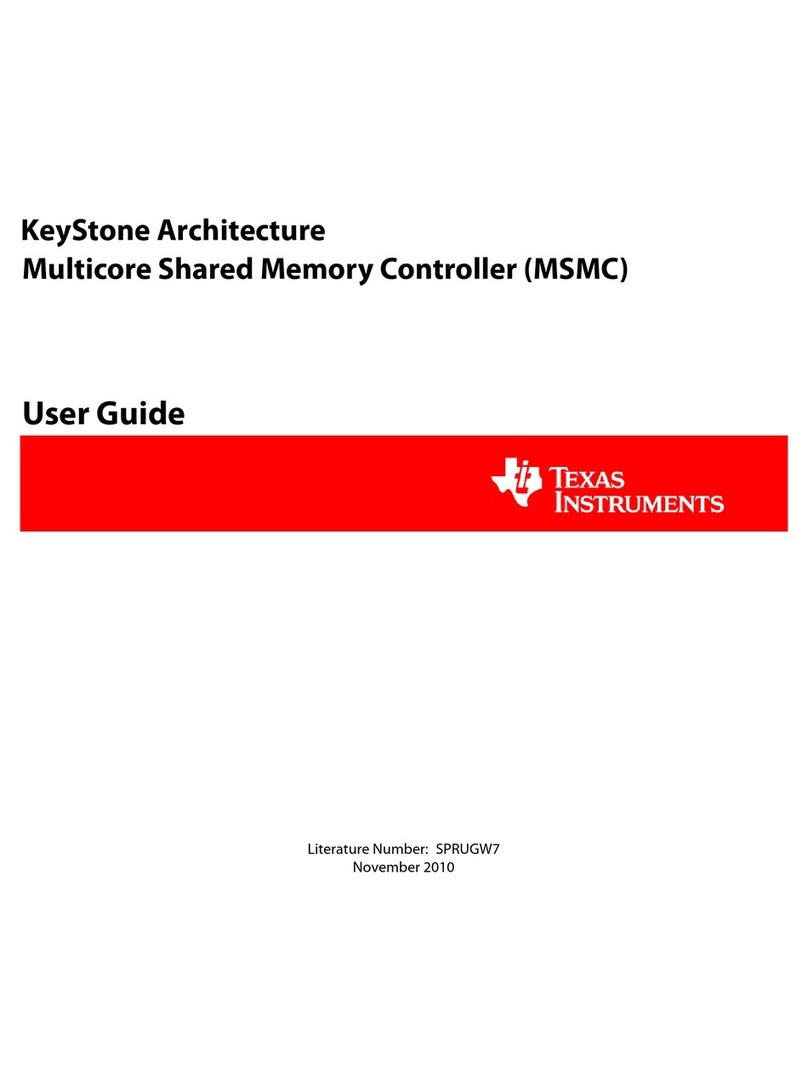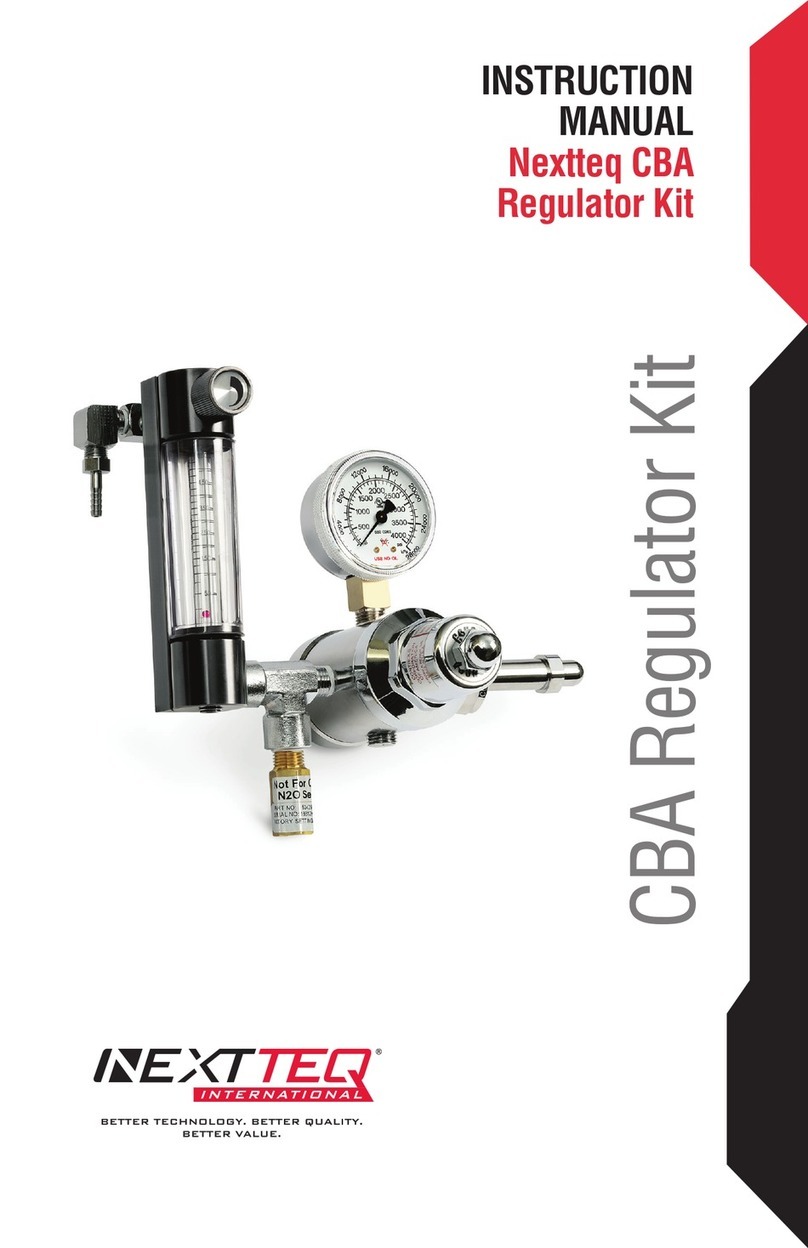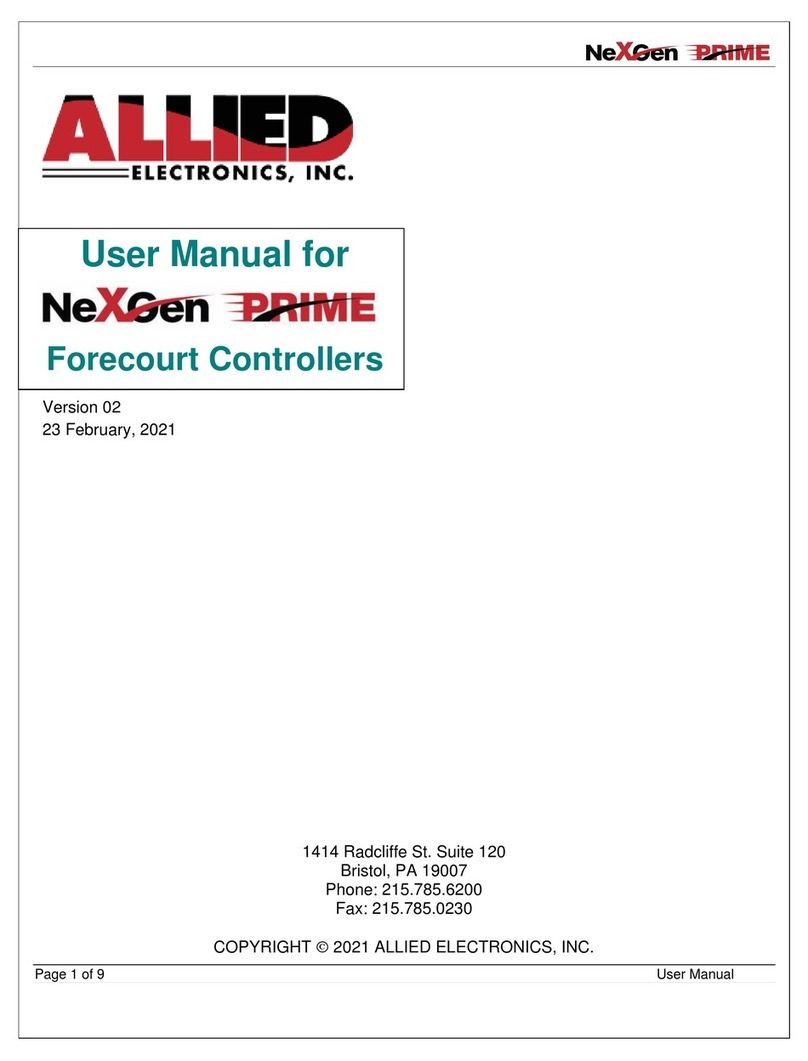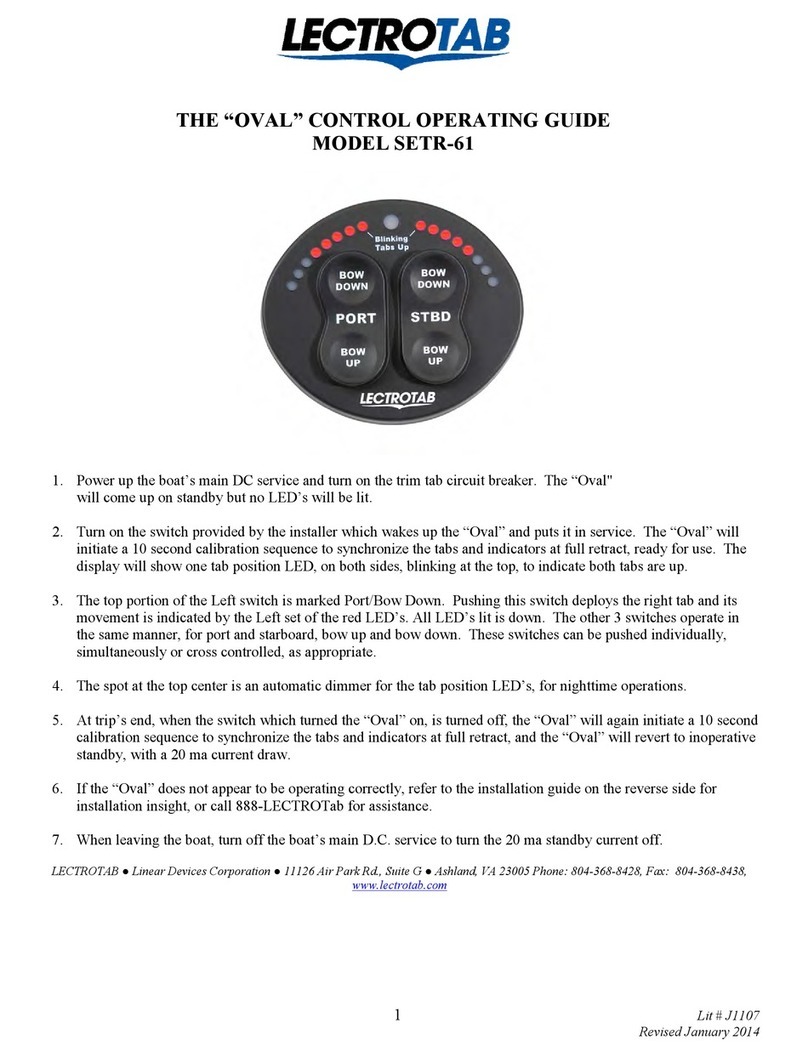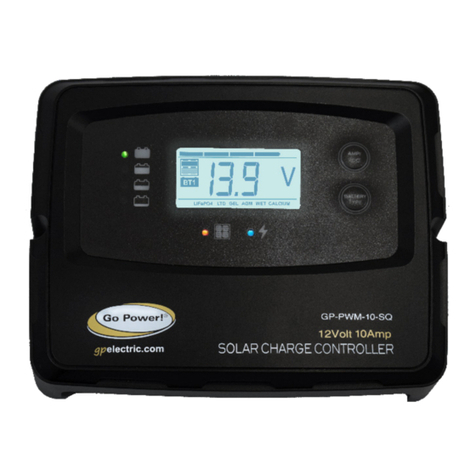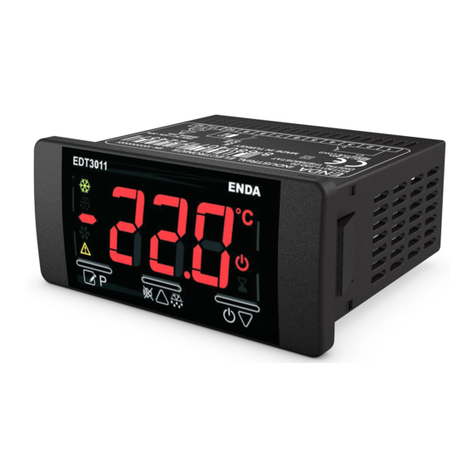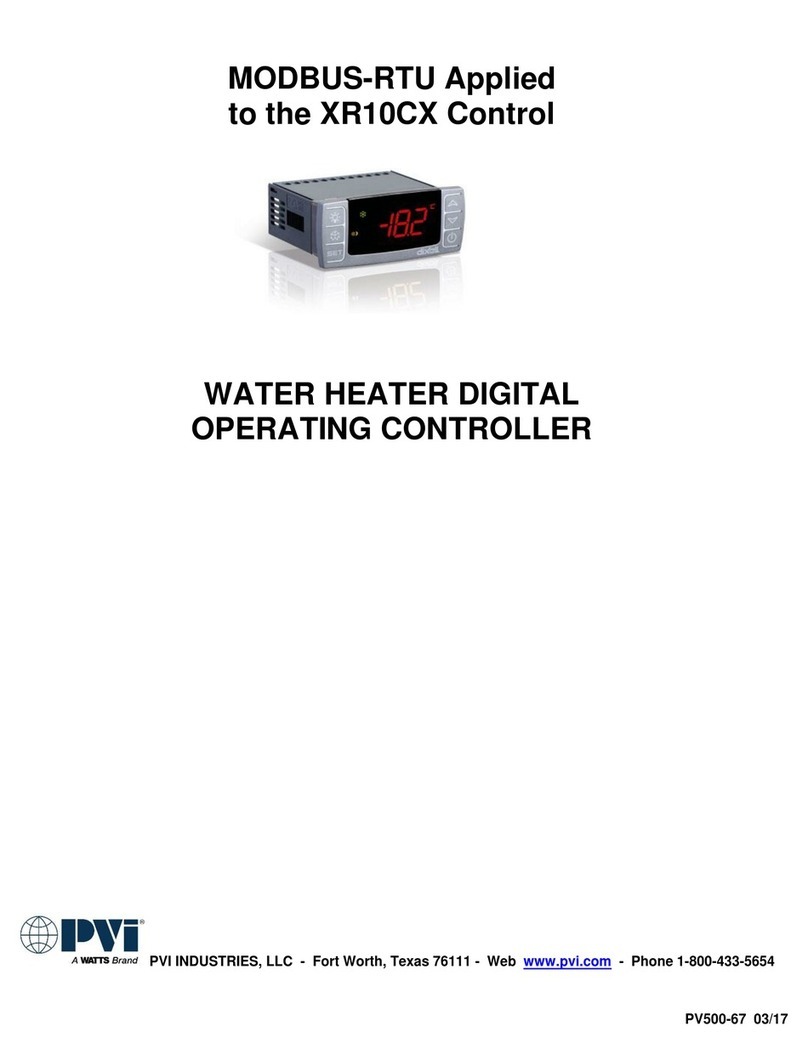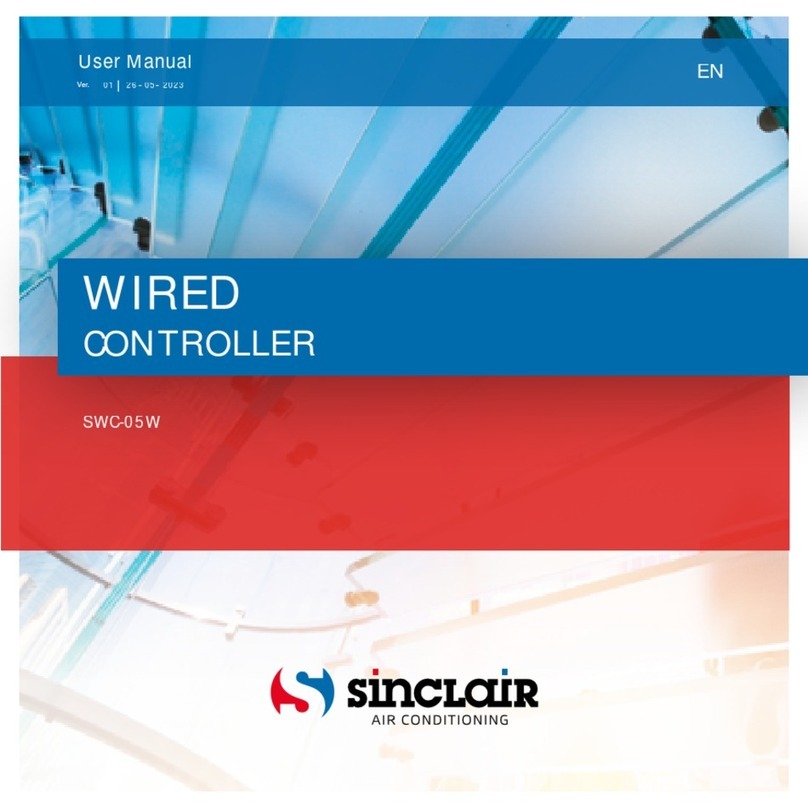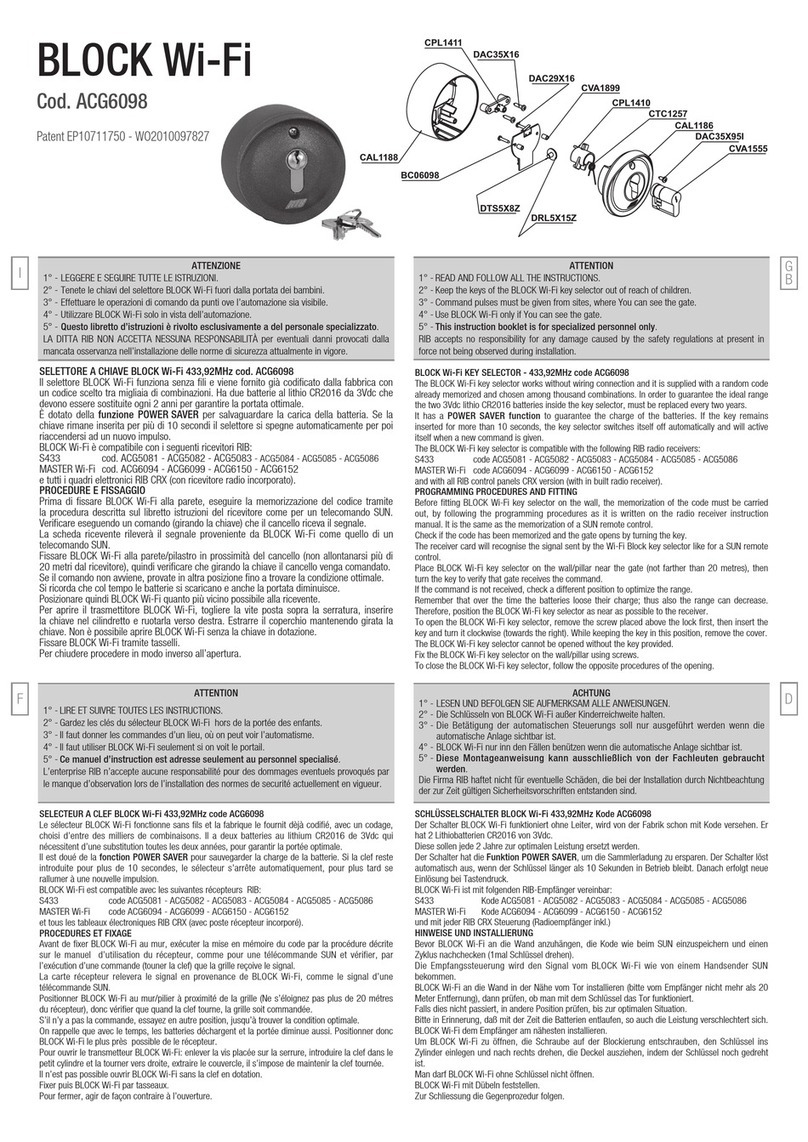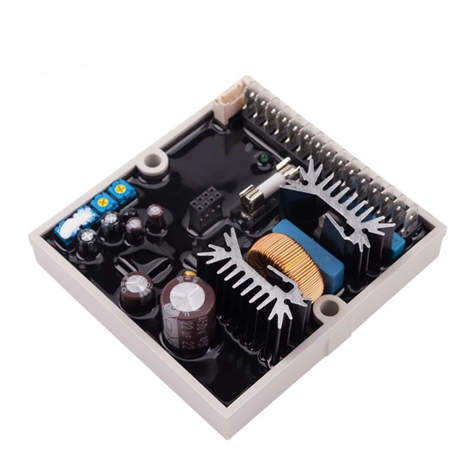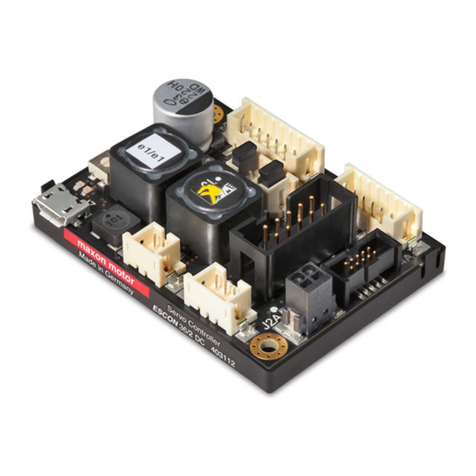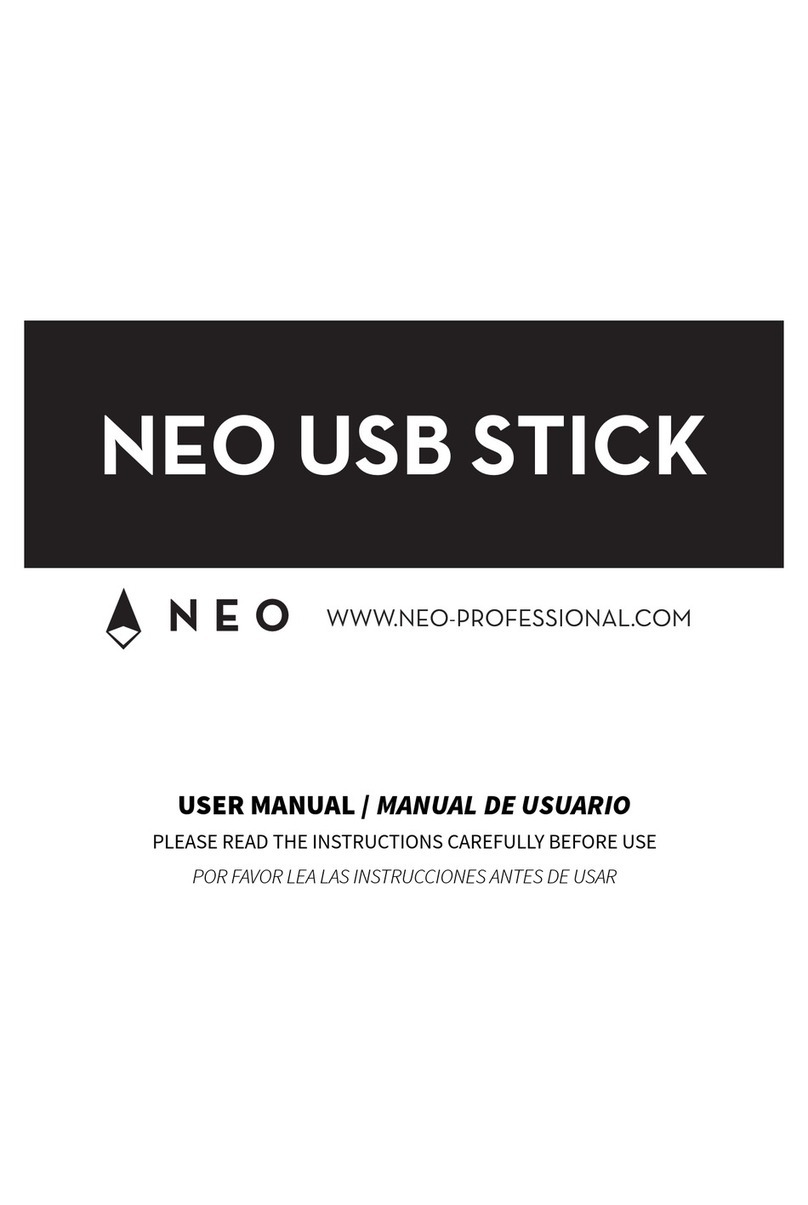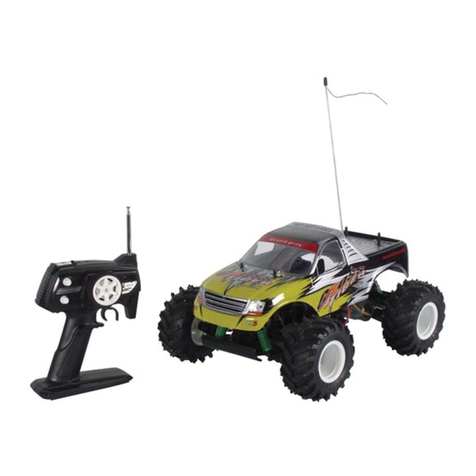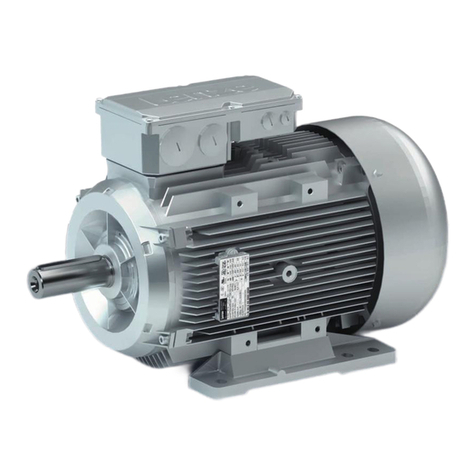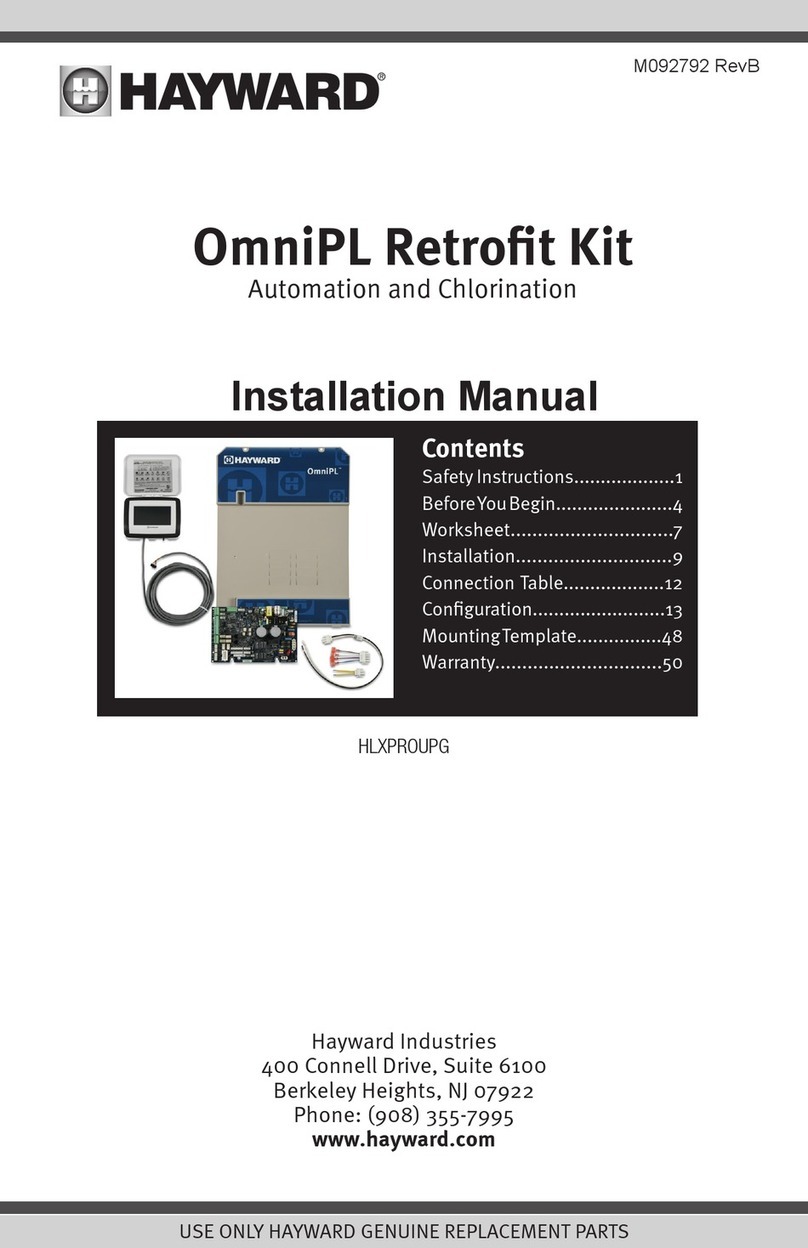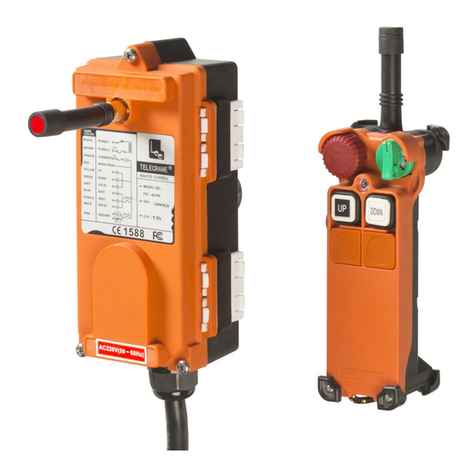Srne ML2420 User manual

ML Maximum Power Point Tracking (MPPT) Series
ML2420—ML2430—ML2440
Solar Charge and Discharge Controller User Manual
Model
ML2420
ML2430
ML2440
Battery voltage
12V/ 24V
Max. solar panel voltage
100V (25°C), 90V (-25°C)
Charging current
20A
30A
40A
Discharging current
20A

Dear users,
Thank you for choosing our product!
Safety Instructions
1. As this controller deals with voltages that exceed the top limit for human safety, do not
operate it before reading this manual carefully and completing safety operation training.
2. The controller has no internal components that need maintenance or service, thus do
not attempt to disassemble or repair the controller.
3. Install the controller indoors, and avoid component exposure and water intrusion.
4. During operation, the radiator may reach a very high temperature, therefore install the
controller at a place with good ventilation conditions.
5. It's recommended that a fuse or breaker be installed outside the controller.
6. Before installing and wiring the controller, make sure to disconnect the photovoltaic
array and the fuse or breaker close to the battery terminals.
7. After installation, check if all connections are solid and reliable so as to avoid loose
connections that may give rise to dangers caused by heat accumulation.
Warning: means the operation in question is dangerous, and you
should get properly prepared before proceeding.
Note: means the operation in question may cause damage.
Tips: means advice or instruction for the operator.

Table of Contents
1. Product Introduction.................................................................................................................. 4
1.1 Product Overview..............................................................................................................4
1.2 Product Features................................................................................................................ 4
1.3 Exterior and Interfaces...................................................................................................... 6
1.4 Introduction to Maximum Power Point Tracking Technology......................................... 7
1.5 Charging Stages Introduction............................................................................................9
2. Product Installation..................................................................................................................12
2.1 Installation Precautions................................................................................................... 12
2.2 Wiring Specifications...................................................................................................... 13
2.3 Installation and Wiring.................................................................................................... 14
3. Product Operation and Display............................................................................................... 18
3.1 LED Indicators................................................................................................................ 18
3.2 Key Operations................................................................................................................ 21
3.3 LCD Startup and Main Interface.....................................................................................21
3.4 Load Mode Setting Interface...........................................................................................23
3.5 System Parameter Settings.............................................................................................. 24
4. Product Protection Function and System Maintenance.......................................................... 25
4.1 Protection Functions........................................................................................................25
4.2 System Maintenance........................................................................................................27
4.3 Abnormality Display and Warnings................................................................................ 28
5. Product Specification Parameters............................................................................................28
5.1 Electric Parameters..........................................................................................................28
5.2 Battery Type Default Parameters (parameters set in monitor software)........................ 29
6. Conversion Efficiency Curve.................................................................................................. 31

6.1 12V System Conversion Efficiency................................................................................ 31
6.1 24V System Conversion Efficiency................................................................................ 31
7. Product Dimensions.................................................................................................................32
1. Product Introduction
1.1 Product Overview
This product can keep monitoring the solar panel's generating power and tracking the
highest voltage and current values (VI) in real time, enabling the system to charge the
battery in maximum power. It's designed to be used in off-grid solar photovoltaic
systems to coordinate operation of the solar panel, battery and load, functioning as the
core control unit in off-grid photovoltaic systems.
This product features an LCD screen which can dynamically display the operating
status, operating parameters, controller logs, control parameters, etc. Users can
conveniently check parameters by the keys, and modify control parameters to cater to
different system requirements.
The controller utilizes standard Modbus communication protocol, making it easy for
users to check and modify system parameters on their own. Besides, by providing free
monitoring software, we give users the maximum convenience to satisfy their varied
needs for remote monitoring.
With comprehensive electronic fault self-detecting functions and powerful electronic
protection functions built inside the controller, component damage caused by
installation errors or system failures can be avoided to the greatest extent possible.
1.2 Product Features
◆With the advanced dual-peak or multi-peak tracking technology, when the solar panel
is shadowed or part of the panel fails resulting in multiple peaks on the I-V curve, the
controller is still able to accurately track the maximum power point.
◆A built-in maximum power point tracking algorithm can significantly improve the
energy utilization efficiency of photovoltaic systems, and raise the charging efficiency
by 15% to 20% compared with the conventional PWM method.
◆A combination of multiple tracking algorithms enables accurate tracking of the

optimum working point on the I-V curve in an extremely short time.
◆The product boasts an optimum MPPT tracking efficiency of up to 99.9%.
◆Advanced digital power supply technologies raise the circuit's energy conversion
efficiency to as high as 98%.
◆Charging program options are available for different types of batteries including gel
batteries, sealed batteries, open batteries, lithium batteries, etc.
◆The controller features a limited current charging mode. When the solar panel power
exceeds a certain level and the charging current is larger than the rated current, the
controller will automatically lower the charging power and bring the charging current to
the rated level.
◆Instantaneous large current startup of capacitive loads is supported.
◆Automatic recognition of battery voltage is supported.
◆LED fault indicators and an LCD screen which can display abnormality information
help users to quickly identify system faults.
◆Historical data storage function is available, and data can be stored for up to a year.
◆The controller is equipped with an LCD screen with which users can not only check
device operating data and statuses, but also modify controller parameters.
◆The controller supports standard Modbus protocol, fulfilling the communication needs
of various occasions.
◆The controller employs a built-in over-temperature protection mechanism. When
temperature surpasses the set value, the charging current will decline in linear
proportion to the temperature so as to curb the temperature rise of the controller,
effectively keeping the controller from being damaged by overheat.
◆Featuring a temperature compensation function, the controller can automatically adjust
charging and discharging parameters in order to extend the battery's service life.

◆TVS lighting protection
1.3 Exterior and Interfaces
No.
Definition
○
1
Transmitting terminal TX
○
2
Receiving terminal RX
○
3
Power supply grounding /Signal grounding
○
4
Power supply grounding /Signal grounding
○
5
Power supply positive
○
6
Power supply positive
○
3
○
4
○
9
○
10
○
11
○
12
○
13
○
6
○
5
○
2
○
1
○
8
○
14
○
15
○
7

Fig. 1-1 Product appearance and interfaces
No.
Item
No.
Item
○
1
Charging indicator
○
10
Battery "+" interface
○
2
Battery indicator
○
11
Battery "-" interface
○
3
Load indicator
○
12
Load "+" interface
○
4
Abnormality indicator
○
13
Load "-" interface
○
5
LCD screen
○
14
External temperature
sampling interface
○
6
Operating keys
○
15
RS232 communication
interface
○
7
Installation hole
○
8
Solar panel "+"
interface
○
9
Solar panel "-"
interface
1.4 Introduction to Maximum Power Point Tracking Technology
Maximum Power Point Tracking (MPPT) is an advanced charging technology that
enables the solar panel to output more power by adjusting the electric module's
operating status. Due to the nonlinearity of solar arrays, there exists a maximum
energy output point (maximum power point) on their curves. Unable to
continuously lock onto this point to charge the battery, conventional controllers
(employing switching and PWM charging technologies) can't get the most of the
power from the solar panel. But a solar charge controller featuring MPPT
technology can continuously track arrays' maximum power point so as to get the
maximum amount of power to charge the battery.
Take a 12V system as an example. As the solar panel's peak voltage (Vpp) is
approximately 17V while the battery's voltage is around 12V, when charging with a

conventional charge controller, the solar panel's voltage will stay at around 12V,
failing to deliver the maximum power. However, the MPPT controller can
overcome the problem by adjusting the solar panel's input voltage and current in
real time, realizing a maximum input power.
Compared with conventional PWM controllers, the MPPT controller can make the
most of the solar panel's max. power and therefore provide larger charging current.
Generally speaking, the latter can raise the energy utilization ratio by 15% to 20%
in contrast with the former.
Fig. 1-2 Solar panel output characteristic curve
Meanwhile, due to changing ambient temperature and illumination conditions, the
max. power point varies frequently, and our MPPT controller can adjust parameter
settings according to the environmental conditions in real time, so as to always keep
the system close to the max. operating point. The whole process is entirely
automatic without the need of human intervention.
P (W)
I (A)
VP curve
VI curve
MPPT point
PWM charging

Fig. 1-3 Relation between solar panel output characteristics and illumination
Fig. 1-4 Relation between solar panel output characteristics and temperature
1.5 Charging Stages Introduction
As one of the charging stages, MPPT can not be used alone, but has to be used
together with boost charging, floating charging, equalizing charging, etc. to
complete charging the battery. A complete charging process includes: fast
Current decreases with dwindling light
Open-circuit voltage decreases with dwindling light
With temperature dropping, current
stays stable and power increases
Solar panel temperature
Open-circuit voltage decreases with rising temperature

charging, sustaining charging and floating charging. The charging curve is as
shown below:
Fig. 1-5 Battery charging stages diagram
a) Fast charging
At the fast charging stage, as the battery voltage has not reached the set value of full voltage (i.e. equalizing/ boost
voltage) yet, the controller will perform MPPT charging on the battery with the maximum solar power. When the
battery voltage reaches the preset value, constant voltage charging will begin.
b) Sustaining charging
When the battery voltage reaches the set value of sustaining voltage, the controller
will switch to constant voltage charging. In this process, no MPPT charging will be
performed, and meanwhile the charging current will also gradually decrease. The
sustaining charging stage itself consists of two sub-stages, i.e. equalizing charging
and boost charging, the two of which are not carried out in a repeated manner, with
the former getting activated once every 30 days.
Time

Boost charging
By default, boost charging generally lasts for 2h, but users can adjust preset values
of duration and boost voltage point according to the actual needs. When the
duration reaches the set value, the system will then switch to floating charging.
Equalizing charging
Warning: risk of explosion!
In equalizing charging, an open lead-acid battery can produce explosive gas, therefore
the battery chamber shall have good ventilation conditions.
Note: risk of equipment damage!
Equalizing charging may raise the battery voltage to a level that may cause
damage to sensitive DC loads. Check and make sure that allowable input
voltages of all the loads in the system are greater than the set value for battery
equalizing charging.
Note: risk of equipment damage!
Overcharge or too much gas generated may damage battery plates and cause
active material on the battery plates to scale off. Equalizing charging to an
excessively high level or for too long a period may cause damage. Read carefully
the actual requirements of the battery deployed in the system.
Some types of batteries benefit from regular equalizing charging which can stir the
electrolyte, balance the battery voltage and finish the electrochemical reaction.
Equalizing charging raises the battery voltage to a higher level than the standard supply
voltage and gasify the battery electrolyte. If the controller then automatically steers the
battery into equalizing charging, the charging duration is 120 mins (default). In order to
avoid too much generated gas or battery overheat, equalizing charging and boost
charging won’t repeat in one complete charging cycle.

Note:
1) When due to the installation environment or working loads, the system can't
continuously stabilize the battery voltage to a constant level, the controller will initiate a
timing process, and 3 hours after the battery voltage reaches the set value, the system
will automatically switch to equalizing charging.
2) If no calibration has been done to the controller clock, the controller will perform
equalizing charging regularly according to its internal clock.
Floating charging
When finishing the sustaining charging stage, the controller will switch to floating
charging in which the controller lowers the battery voltage by diminishing the
charging current and keeps the battery voltage at the set value of floating charging
voltage. In the floating charging process, very light charging is carried out for the
battery to maintain it at full state. At this stage, the loads can access almost all the
solar power. If the loads consume more power than the solar panel could provide, the
controller will not be able to keep the battery voltage at the floating charging stage.
When the battery voltage drops to the set value for returning to boost charging, the
system will exit floating charging and reenter into fast charging.
2. Product Installation
2.1 Installation Precautions
◆Be very careful when installing the battery. For open lead-acid batteries, wear a
pair of goggles during installation, and in case of contact with battery acid, flush
with water immediately.
◆In order to prevent the battery from being short-circuited, no metal objects shall be
placed near the battery.
◆Acid gas may be generated during battery charging, thus make sure the ambient

environment is well ventilated.
◆Keep the battery away from fire sparks, as the battery may produce flammable gas.
◆When installing the battery outdoors, take sufficient measures to keep the battery
from direct sunlight and rain water intrusion.
◆Loose connections or corroded wire may cause excessive heat generation which
may further melt the wire's insulation layer and burn surrounding materials, and even
cause a fire, therefore make sure all connections are tightened securely. Wires had
better be fixed properly with ties, and when needs arise to move things, avoid wire
swaying so as to keep connections from loosening.
◆When connecting the system, the output terminal's voltage may exceed the top
limit for human safety. If operation needs to be done, be sure to use insulation tools
and keep hands dry.
◆The wiring terminals on the controller can be connected with a single battery or a
pack of batteries. Following descriptions in this manual apply to systems employing
either a single battery or a pack of batteries.
◆Follow the safety advice given by the battery manufacturer.
◆When selecting connection wires for the system, follow the criterion that the
current density is not larger than 4A/mm2.
◆Connect the controller's earth terminal to the ground.
2.2 Wiring Specifications
Wiring and installation methods must comply with national and local electrical
specifications.
The wiring specifications of the battery and loads must be selected according to
rated currents, and see the following table for wiring specifications:

Model
Rated
charging
current
Rated
discharging
current
Battery wire
diameter
(mm2)
Load wire
diameter
(mm2)
ML2420
20A
20A
5
5
ML2430
30A
20A
6
5
ML2440
40A
20A
10
5
2.3 Installation and Wiring
Warning: risk of explosion! Never install the controller and an open
battery in the same enclosed space! Nor shall the controller be installed in an
enclosed space where battery gas may accumulate.
Warning: danger of high voltage! Photovoltaic arrays may produce a
very high open-circuit voltage. Open the breaker or fuse before wiring, and be
very careful during the wiring process.
Note: when installing the controller, make sure that enough air flows
through the controller's radiator, and leave at least 150 mm of space both above
and below the controller so as to ensure natural convection for heat dissipation.
If the controller is installed in an enclosed box, make sure the box delivers
reliable heat dissipation effect.

Step 1: choose the installation site
Do not install the controller at a place that is subject to direct sunlight,
high temperature or water intrusion, and make sure the ambient
environment is well ventilated.
Step 2: first place the installation guide plate at a proper position, use a
marking pen to mark the mounting points, then drill 4 mounting holes at the
4 marked points, and fit screws in.
Step 3: fix the controller
Aim the controller's fixing holes at the screws fit in Step 2 and mount the
controller on.
Hot air
Cold air
Fig. 2.1 Installation and heat dissipation

Step 4: wire
First remove the two screws on the controller, and then begin wiring
operation. In order to guarantee installation safety, we recommend the
following wiring order; however, you can choose not to follow this order
and no damage will be incurred to the controller.
○
1Connecting to external temperature sampling interface
○
2Connecting communication cable
○
3Connecting power cable

Warning: risk of electric shock! We strongly recommend that fuses or
breakers be connected at the photovoltaic array side, load side and battery side so as to
avoid electric shock during wiring operation or faulty operations, and make sure the
fuses and breakers are in open state before wiring.
Warning: danger of high voltage! Photovoltaic arrays may produce a very
high open-circuit voltage. Open the breaker or fuse before wiring, and be very careful
during the wiring process.
Warning: risk of explosion! Once the battery's positive and negative
terminals or leads that connect to the two terminals get short-circuited, a fire or
explosion will occur. Always be careful in operation.
First connect the battery, then the load, and finally the solar panel. When wiring, follow
the order of first "+" and then "-".
○
4Power on
After connecting all power wires solidly and reliably, check again whether wiring is
correct and if the positive and negative poles are reversely connected. After confirming
that no faults exist, first close the fuse or breaker of the battery, then see whether the
LED indicators light up and the LCD screen displays information. If the LCD screen
fails to display information, open the fuse or breaker immediately and recheck if all
connections are correctly done.
If the battery functions normally, connect the solar panel. If sunlight is intense enough,
the controller's charging indicator will light up or flash and begin to charge the battery.
After successfully connecting the battery and photovoltaic array, finally close the fuse or
breaker of the load, and then you can manually test whether the load can be normally
turned on and off. For details, refer to information about load working modes and
operations.
Warning: when the controller is in normal charging state, disconnecting the
battery will have some negative effect on the DC loads, and in extreme cases, the loads
may get damaged.

Warning: within 10 minutes after the controllers stops charging, if the
battery's poles are reversely connected, internal components of the controller may get
damaged.
Note:
1) The battery's fuse or breaker shall be installed as close to the battery side as
possible, and it's recommended that installation distance be not more than
150mm.
2) If no remote temperature sensor is connected to the controller, the battery
temperature value will stay at 25 °C.
3) If an inverter is deployed in the system, directly connect the inverter to the
battery, and do not connect it to the controller's load terminals.
3. Product Operation and Display
3.1 LED Indicators
○
1---PV array indicator
Indicating the controller's current charging
mode.
○
2---BAT indicator
Indicating the battery's current state.
○
3---LOAD indicator
Indicating the loads' On/ Off and state.
○
4---ERROR indicator
Indicating whether the controller is
functioning normally.
PV array indicator:
No.
Indicator state
Charging
Steady on, charging in max. power
Slow flashing, boost charging
Single flashing, floating charging
Quick flashing, equalizing charging
Double flashing, current-limited charging

state
○
1
Steady on
MPPT
charging
○
2
Slow flashing
(a cycle of 2s with on and off
each lasting for 1s)
Boost
charging
○
3
Single flashing
(a cycle of 2s with on and off
lasting respectively for 0.1s and
1.9s)
Floating
charging
○
4
Quick flashing
(a cycle of 0.2s with on and off
each lasting for 0.1s)
Equalizing
charging
○
5
Double flashing
(a cycle of 2s with on for 0.1s, off
for 0.1s, on again for 0.1s, and off
again for 1.7s)
Current-limited
charging
○
6
Off
No charging
BAT indicator:
Indicator state
Battery state
Steady on
Normal battery voltage
Slow flashing
(a cycle of 2s with on and off
each lasting for 1s)
Battery
over-discharged

Quick flashing
(a cycle of 0.2s with on and off
each lasting for 0.1s)
Battery over-voltage
LOAD indicator:
Indicator state
Load state
Off
Load turned off
Quick flashing
(a cycle of 0.2s with on and off
each lasting for 0.1s)
Load overloaded/
short-circuited
Steady on
Load functioning
normally
ERROR indicator:
Indicator state
Abnormality
indication
Off
System operating
normally
Steady on
System malfunctioning
This manual suits for next models
4
Table of contents
Other Srne Controllers manuals
